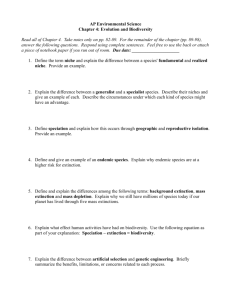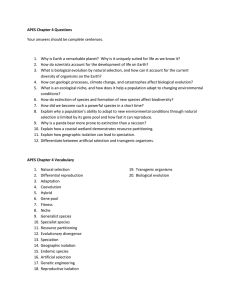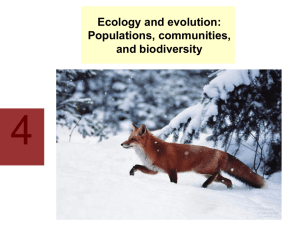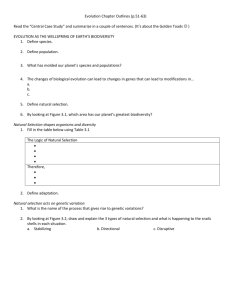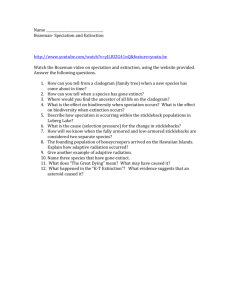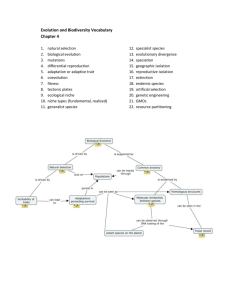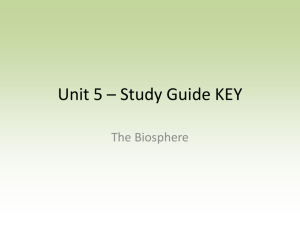4 Ecology and evolution: Populations, communities, and biodiversity
advertisement
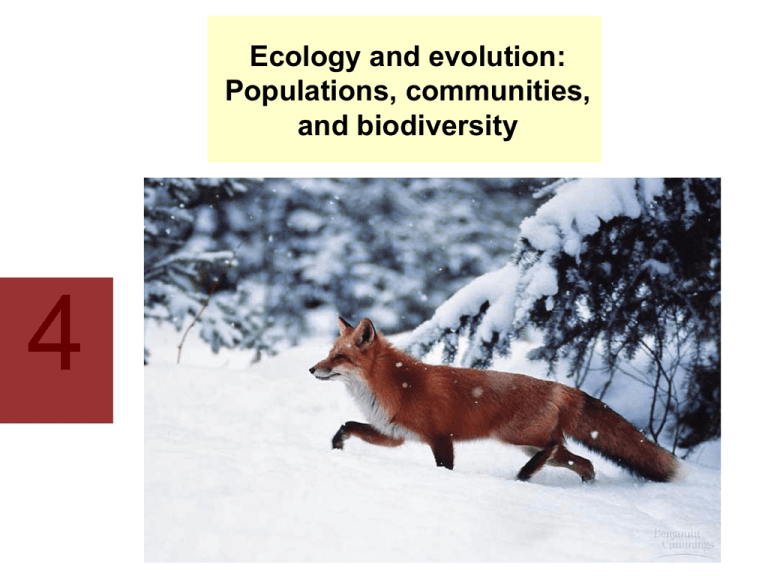
Ecology and evolution: Populations, communities, and biodiversity 4 This lecture will help you understand: • How evolution generates biodiversity • Speciation, extinction, and the “biodiversity crisis” • Population ecology • Community ecology • Species interactions • Conservation challenges • Evolution by natural selection Key Words adaptation adaptive trait age distribution age structure age structure diagrams allopatric speciation anthropogenic artificial selection biodiversity biological diversity biosphere biotic potential carnivores carrying capacity climax community clumped distribution community competition decomposers density dependent detritivores ectoparasites Emigration endemic endoparasites environmental resistance evolution exponential growth extinction food chain food web fossil fossil record growth rate habitat selection habitats herbivores heritable host immigration interspecific competition intraspecific competition invasive species keystone species K-strategist limiting factors logistic growth mass extinction mutations mutualism natural selection niche omnivores parasite parasitism Key Words phylogenetic trees pioneer species pollination population density population dispersion population distribution population growth curves population size predation predator prey primary consumers primary succession random distribution resource partitioning r-strategists secondary consumers secondary succession sex ratio speciation species succession symbioses tertiary consumers trophic levels uniform distribution Central Case: Striking Gold in a Costa Rican Cloud Forest • The golden toad of Monteverde, discovered in 1964, had disappeared 25 years later. • Researchers determined that warming and drying of the forest was most likely responsible for its extinction. • As the global climate changes, more such events can be expected. Biodiversity Biodiversity, or biological diversity, is the sum of an area’s organisms, considering the diversity of species, their genes, their populations, and their communities. A species is a particular type of organism; a population or group of populations whose members share certain characteristics and can freely breed with one another and produce fertile offspring. Biodiversity Costa Rica’s Monteverde cloud forest is home to many species and possesses great biodiversity. Figure 5.1 Natural selection Natural selection rests on three indisputable facts: • Organisms produce more offspring than can survive. • Individuals vary in their characteristics. • Many characteristics are inherited by offspring from parents. Natural selection THEREFORE, logically… • Some individuals will be better suited to their environment; they will survive and reproduce more successfully. • These individuals will transmit more genes to future generations. • Future generations will thus contain more genes from better-suited individuals. • Thus, characteristics will evolve over time to resemble those of the better-suited ancestors. Natural selection Fitness = the likelihood that an individual will reproduce and/or the number of offspring an individual produces over its lifetime Adaptive trait, or adaptation = a trait that increases an individual’s fitness Natural selection Evidence of natural selection is all around us: In nature … Diverse bills have evolved among species of Hawaiian honeycreepers. Figure 4.23a Beak Types Resulting From Natural Selection Fruit and seed eaters Insect and nectar eaters Greater Koa-finch Kuai Akialoa Amakihi Kona Grosbeak Crested Honeycreeper Akiapolaau Maui Parrotbill Apapane Unknown finch ancestor Natural selection Evidence of natural selection is all around us: … and in our domesticated organisms. Dog breeds, types of cattle, improved crop plants—all result from artificial selection (natural selection conducted by human breeders). Figure 4.23b Speciation The process by which new species come into being Speciation is an evolutionary process that has given Earth its current species richness—more than 1.5 million described species and likely many million more not yet described by science. Allopatric speciation is considered the dominant mode of speciation, and sympatric speciation also occurs. Allopatric speciation 1. Single interbreeding population 2. Population divided by a barrier; subpopulations isolated Figure 5.2 Allopatric speciation 3. The two populations evolve independently, diverge in their traits. 4. Populations reunited when barrier removed, but are now different enough that they don’t interbreed. Figure 5.2 Allopatric speciation Many geological and climatic events can serve as barriers separating populations and causing speciation. on. Chemical Evolution (1 billion years) Formation of the earth’s early crust and atmosphere Small organic molecules form in the seas Large organic molecules (biopolymers) form in the seas Biological Evolution (3.7 billion years) Single-cell prokaryotes form in the seas Single-cell eukaryotes form in the seas Variety of multicellular organisms form, first in the seas and later on land First protocells form in the seas Stanley Miller's experiment animation. Click to view animation. Stabilizing Selection Click to view animation. Disruptive Selection Click to view animation. Number of individuals Niches and Natural Selection Niche separation Specialist species with a narrow niche Niche breadth Region of niche overlap Resource use Generalist species with a broad niche Various Niches and Their Adaptations Herring gull is a tireless scavenger Black skimmer seizes small fish at water surface Flamingo feeds on minute organisms in mud Scaup and other diving ducks feed on mollusks, crustaceans, and aquatic vegetation Brown pelican dives for fish, which it locates from the air Avocet sweeps bill through mud and surface water in search of small crustaceans, insects, and seeds Dowitcher probes deeply into mud in search of snails, marine worms, and small crustaceans Oystercatcher feeds on clams, mussels, and Louisiana heron wades into other shellfish into which water to seize small fish it pries its narrow beak Ruddy turnstone searches under shells and pebbles for small invertebrates Knot (a sandpiper) picks up worms and small crustaceans left by receding tide Piping plover feeds on insects and tiny crustaceans on sandy beaches Geographic Separation Arctic Fox Northern population Early fox population Spreads northward and southward and separates Different environmental conditions lead to different selective pressures and evolution into two different species. Adapted to cold through heavier fur, short ears, short legs, short nose. White fur matches snow for camouflage. Southern population Gray Fox Adapted to heat through lightweight fur and long ears, legs, and nose, which give off more heat. Mimicry Span worm Wandering leaf insect Poison dart frog Viceroy butterfly mimics monarch butterfly Bombardier beetle Hind wings of io moth resemble eyes of a much larger animal Foul-tasting monarch butterfly When touched, the snake caterpillar changes shape to look like the head of a snake Phylogenetic trees Life’s diversification results from countless speciation events over vast spans of time. Evolutionary history of divergence is shown with diagrams called phylogenetic trees. Similar to family genealogies, these show relationships among organisms. Phylogenetic trees These trees are constructed by analyzing patterns of similarity among present-day organisms. This tree shows all of life’s major groups. Figure 5.4 Phylogenetic trees Within the group Animals in the previous slide, one can infer a tree of the major animal groups. Figure 5.4 Phylogenetic trees And within the group Vertebrates in the previous slide, one can infer relationships of the major vertebrate groups, and so on… Figure 5.4 Extinction Extinction is the disappearance of an entire species from the face of the Earth. Average time for a species on Earth is ~1–10 million years. Species currently on Earth = the number formed by speciation minus the number removed by extinction. Extinction Some species are more vulnerable to extinction than others: • Species in small populations • Species adapted to a narrowly specialized resource or way of life Monteverde’s golden toad was apparently such a specialist, and lived in small numbers in a small area. Extinction Some species are more vulnerable to extinction than others: • Species in small populations • Species adapted to a narrowly specialized resource or way of life Monteverde’s golden toad was apparently such a specialist, and lived in small numbers in a small area. Life’s hierarchy of levels Life occurs in levels: from the atom up to the molecule to the cell to the tissues to the organs to the organism… Figure 5.7 Life’s hierarchy of levels … and from the organism to the population to the community to the ecosystem to the biosphere. Ecology deals with these levels, from the organism up to the biosphere. Figure 5.7 Ecology The study of: the distribution and abundance of organisms, the interactions among them, and the interactions between organisms and their abiotic environments Ecology is NOT environmental advocacy! (= a common MISUSE of the term) Habitat and niche Habitat = the specific environment where an organism lives (including living and nonliving elements: rocks, soil, plants, etc.) Habitat selection = the process by which organisms choose habitats among the options encountered Niche = an organism’s functional role in a community (feeding, flow of energy and matter, interactions with other organisms, etc.) Population ecology Population = a group of individuals of a species that live in a particular area Several attributes help predict population dynamics (changes in population): • Population size • Population density • Population distribution • Age structure • Sex ratio Population size Number of individuals present at a given time Population size for the golden toad was 1,500+ in 1987, and zero a few years later. Population density Number of individuals per unit area or, Number of individuals per unit volume Population density for the harlequin frog increased locally as streams dried and frogs clustered in splash zones. Population distribution Spatial arrangement of individuals Clumped Random Uniform Figure 5.8 Age structure Or age distribution = relative numbers of individuals of each age or age class in a population Age structure diagrams, or age pyramids, show this information. Figure 5.9 Age structure Pyramid weighted toward young: population growing Pyramid weighted toward old: population declining Figure 5.9 Sex ratio Ratio of males to females in a population Even ratios (near 50/50) are most common. Fewer females causes slower population growth. Note human sex ratio biased toward females at oldest ages. Population growth Populations grow, shrink, or remain stable, depending on rates of birth, death, immigration, and emigration. (birth rate + immigration rate) – (death rate + emigration rate) = population growth rate Exponential growth Unregulated populations increase by exponential growth: Growth by a fixed percentage, rather than a fixed amount. Similar to growth of money in a savings account Exponential growth in a growth curve Population growth curves show change in population size over time. Scots pine shows exponential growth Figure 5.10 Limits on growth Limiting factors restrain exponential population growth, slowing the growth rate down. Population growth levels off at a carrying capacity—the maximum population size of a given species an environment can sustain. Initial exponential growth, slowing, and stabilizing at carrying capacity is shown by a logistic growth curve. Logistic growth curve Figure 5.11 Population growth: Logistic growth Logistic growth (shown here in yeast from the lab) is only one type of growth curve, however. Figure 5.12a Population growth: Oscillations Some populations fluctuate continually above and below carrying capacity, as with this mite. Figure 5.12b Population growth: Dampening oscillations In some populations, oscillations dampen, as population size settles toward carrying capacity, as with this beetle. Figure 5.12c Population growth: Crashes Some populations that rise too fast and deplete resources may then crash, as with reindeer on St. Paul Island. Figure 5.12d Density dependence Often, survival or reproduction lessens as populations become more dense. Density-dependent factors (disease, predation, etc.) account for the logistic growth curve. Biotic potential and reproductive strategies Species differ in strategies for producing young. Species producing lots of young (insects, fish, frogs, plants) have high biotic potential. Others, such as mammals and birds, produce few young. However, those with few young give them more care, resulting in better survival. POPULATION SIZE Biotic Potential Growth factors (biotic potential) Abiotic Favorable light Favorable temperature Favorable chemical environment (optimal level of critical nutrients) Biotic High reproductive rate Generalized niche Adequate food supply Suitable habitat Ability to compete for resources Ability to hide from or defend against predators Ability to resist diseases and parasites Ability to migrate and live in other habitats Ability to adapt to environmental change Decrease factors (environmental resistance) Abiotic Too much or too little light Temperature too high or too low Unfavorable chemical environment (too much or too little of critical nutrients) Biotic Low reproductive rate Specialized niche Inadequate food supply Unsuitable or destroyed habitat Too many competitors Insufficient ability to hide from or defend against predators Inability to resist diseases and parasites Inability to migrate and live in other habitats Inability to adapt to environmental change Survivorship Late loss Percentage surviving (log scale) 100 10 1 0 Early loss K-strategists Terms come from: K = symbol for carrying capacity. (Populations tend to stabilize near K.) K-Selected Species Saguaro Elephant Fewer, larger offspring High parental care and protection of offspring Later reproductive age Most offspring survive to reproductive age Larger adults Adapted to stable climate and environmental conditions Lower population growth rate (r) Population size fairly stable and usually close to carrying capacity (K) Specialist niche High ability to compete Late successional species r-Selected r-Selected Species Dandelion Cockroach Many small offspring r = intrinsic rate of population increase. (Populations can potentially grow fast, have high r.) Little or no parental care and protection of offspring Early reproductive age Most offspring die before reaching reproductive age Small adults Adapted to unstable climate and environmental conditions High population growth rate (r) Population size fluctuates wildly above and below carrying capacity (K) Generalist niche Low ability to compete Early successional species Community ecology Ecologists interested in how populations or species interact with one another study community ecology. Community = a group of populations of different species that live in the same place at the same time e.g., Monteverde cloud forest community–golden toads, quetzals, trees, ferns, soil microbes, etc. Roles in communities: Producers By eating different foods, organisms are at different trophic levels, and play different roles, in the community Plants and other photosynthetic organisms are producers. Figure 5.14b Primary consumers Animals that eat plants are primary consumers, or herbivores, and are at the second trophic level. Figure 5.14b Secondary consumers Animals that eat herbivores are secondary consumers, at the third trophic level. Figure 5.14b Detritivores and decomposers Detritivores and decomposers eat nonliving organic matter; they recycle nutrients. Figure 5.14b Trophic levels Together these comprise trophic levels. Figure 5.14b Food chains and webs We can represent feeding interactions (and thus energy transfer) in a community: Food chain: Simplified linear diagram of who eats whom Food web: Complex network of who eats whom Food web for an eastern deciduous forest Figure 5.14a Keystone species Species that have especially great impacts on other community members and on the community’s identity If keystone species are removed, communities change greatly. A “keystone” holds an arch together. Figure 5.15a Keystone species When the keystone sea otter is removed, sea urchins overgraze kelp and destroy the kelp forest community. Figure 5.15b Balance of Life (a) Southern sea otter (b) Sea Urchin (c) Kelp bed Predation One species, the predator, hunts, kills, and consumes the other, its prey. Figure 5.16 Predation drives adaptations in prey Cryptic coloration: Camouflage to hide from predators Warning coloration: Bright colors warn that prey is toxic Mimicry: Fool predators (here, caterpillar mimics snake) Figure 5.18 Competition When multiple species seek the same limited resource Interspecific competition is between two or more species. Intraspecific competition is within a species. Usually does not involve active fighting, but subtle contests to procure resources. Interspecific competition Different outcomes: Competitive exclusion = one species excludes the other from a resource. Species coexistence = both species coexist at a ratio of population sizes, or stable equilibrium. Competitive Exclusion Principle Click to view animation. Interspecific competition Adjusting resource use, habitat use, or way of life over evolutionary time leads to: Resource partitioning = species specialize in different ways of exploiting a resource. Character displacement = physical characters evolve to become different to better differentiate resource use. Resource partitioning Tree-climbing bird species exploit insect resources in different ways. Figure 5.20 Parasitism One species, the parasite, exploits the other species, the host, gaining benefits and doing harm. Figure 5.21 Mutualism Both species benefit one another. Hummingbird pollinates flower while gaining nectar for itself. Figure 5.22 Mutualism Oxpeckers and black rhinoceros Mycorrhizae fungi on juniper seedlings in normal soil Clown fish and sea anemone Lack of mycorrhizae fungi on juniper seedlings in sterilized soil Succession A series of regular, predictable, quantifiable changes through which communities go • Primary succession: Pioneer species colonize a newly exposed area (lava flows, glacial retreat, dried lake bed). • Secondary succession: The community changes following a disturbance (fire, hurricane, logging). Primary aquatic succession 1. Open pond 2. Plants begin to cover surface; sediment deposited 3. Pond filled by sediment; vegetation grows over site Figure 5.24 Secondary terrestrial succession Figure 5.23 Succession Click to view animation. Ecosystem Characteristics at Immature and Mature Stages of Ecological Succession Characteristic Immature Ecosystem (Early Successional Stage) Immature Ecosystem (Late Successional Stage) Small Large Low High Mostly producers, few decomposers Mixture of producers, consumers, and decomposers Ecosystem Structure Plant size Species diversity Trophic structure Ecological niches Community organization (number of interconnecting links) Few, mostly generalized Many, mostly specialized Low High Ecosystem Function Biomass Net primary productivity Food chains and webs Low High High Low Simple, mostly plant with few decomposers herbivore Complex, dominated by decomposers Efficiency of nutrient recycling Low High Efficiency of energy use High Low Table Invasive species A species that spreads widely and rapidly becomes dominant in a community, changing the community’s normal functioning Many invasive species are non-native, introduced from other areas. Purple loosestrife invades a wetland. Figure 5.25 Climate change and Monteverde Monteverde’s cloud forest become drier in the 1970s– 1990s. Number of dry days rose Stream flow fell From The Science behind the Stories Climate change and Monteverde Cool ocean; low clouds; mountains receive moisture Warm ocean; high clouds; mountains get less moisture From The Science behind the Stories Viewpoints: Conservation of Monteverde? Robert Lawton “A few committed people can have an impact. Conservation efforts must take into account local social aspirations. Conservation can lead to economic success. But local conservation is not enough.” Nathaniel Wheelwright “Whatever negative local impact the steady onslaught of ecotourists may have on resplendent quetzals and howler monkeys, it is more than compensated for by inspiring people to appreciate tropical forests and their own natural heritage.” From Viewpoints Conclusions: Challenges Earth’s biodiversity faces a mass extinction event caused by human actions. Climate change may alter communities and cause species extinctions. Invasive species pose a new threat to community stability. Conservation efforts need to consider local economies and social conditions in order to succeed. Evolution and natural selection provide a strong explanation for how Earth’s life diversified. Conclusions: Solutions There is still time to avoid most species extinctions threatened by human actions. Studies like those at Monteverde are clarifying the effects of climate change. Ecological restoration efforts can remove invasive species and restore original communities. Many conservation efforts today are locally run or promote local economies. QUESTION: Review Allopatric speciation requires…? a. Natural selection b. More than two populations c. Some kind of barrier separating populations d. Sex ratio bias in one population QUESTION: Review Which is a K-strategist? a. A dragonfly that lays 300 eggs and flies away b. An oak tree that drops its acorns each year c. A bamboo plant that flowers only once every 20 years d. A human who raises three children e. A fish on the second trophic level QUESTION: Review Which of the following lists of trophic levels is in the correct order? a. Producer, secondary consumer, herbivore b. Producer, herbivore, secondary consumer c. Secondary consumer, producer, detritivore d. Herbivore, carnivore, producer QUESTION: Review Primary succession would take place on all of the following EXCEPT…? a. The slopes of a Hawaiian volcano’s new lava flow b. A South Carolina coastal forest after a hurricane c. Alaskan land just uncovered as a glacier melts d. A new island formed by falling levels of a reservoir in Ohio QUESTION: Weighing the Issues Can we continue raising the Earth’s carrying capacity for humans by developing technology and using resources more efficiently? a. Yes, our growth can continue indefinitely. b. Our growth can continue some more, but will eventually be halted by limiting factors. c. No, we cannot raise Earth’s carrying capacity for ourselves any longer. QUESTION: Weighing the Issues Are national parks and preserves the best way to conserve biodiversity? a. Yes, because species depend on their habitats and intact communities being protected. b. No, because climate change can ruin conservation efforts if it changes conditions inside preserves. c. Ecotourism and encouraging local interest in conservation is more important than establishing parks. QUESTION: Interpreting Graphs and Data You would expect this population to be…? a. Growing rapidly b. Shrinking rapidly c. Stable in size d. Oscillating in size Figure 5.9 QUESTION: Interpreting Graphs and Data How can you tell that this population growth curve shows exponential growth? a. Population is increasing. b. Data points match curve closely. c. Population is rising by the same number during each interval. d. Population is rising by the same percentage during each interval. Figure 5.10 QUESTION: Interpreting Graphs and Data This shows growth ending at a(n) . a. exponential… carrying capacity b. intrinsic… equilibrium c. logistic… carrying capacity d. runaway… equilibrium e. logistic… extinction Figure 5.12a QUESTION: Viewpoints What is the most important lesson we can learn from the Monteverde preserve? a. Preserves do little good if species can become extinct inside them. b. Climate change means that we will need more than preserves to save all species. c. Ecotourism and local participation can make for successful conservation.
